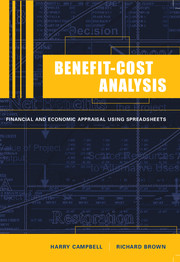Book contents
- Frontmatter
- Contents
- List of figures
- List of tables
- Preface
- Acknowledgements
- 1 Benefit-Cost Analysis: Introduction and Overview
- 2 Investment Appraisal: Principles
- 3 Investment Appraisal: Decision-Rules
- 4 Private Benefit-Cost Analysis: Financial Analysis
- 5 Efficiency Benefit-Cost Analysis
- 6 Calculating the Net Benefits to the Referent Group
- 7 Consumer and Producer Surplus in Benefit-Cost Analysis
- 8 Valuing Traded and Non-traded Commodities in Benefit-Cost Analysis
- 9 Incorporating Risk in Benefit-Cost Analysis
- 10 The Social Discount Rate, Cost of Public Funds, and the Value of Information
- 11 Weighting Net Benefits to Account for Income Distribution
- 12 Valuation of Non-marketed Goods
- 13 Economic Impact Analysis
- 14 Writing the Benefit-Cost Analysis Report
- Appendix 1 Case Study Assignment
- Appendix 2 Discount and Annuity Tables
- Index
11 - Weighting Net Benefits to Account for Income Distribution
Published online by Cambridge University Press: 05 September 2012
- Frontmatter
- Contents
- List of figures
- List of tables
- Preface
- Acknowledgements
- 1 Benefit-Cost Analysis: Introduction and Overview
- 2 Investment Appraisal: Principles
- 3 Investment Appraisal: Decision-Rules
- 4 Private Benefit-Cost Analysis: Financial Analysis
- 5 Efficiency Benefit-Cost Analysis
- 6 Calculating the Net Benefits to the Referent Group
- 7 Consumer and Producer Surplus in Benefit-Cost Analysis
- 8 Valuing Traded and Non-traded Commodities in Benefit-Cost Analysis
- 9 Incorporating Risk in Benefit-Cost Analysis
- 10 The Social Discount Rate, Cost of Public Funds, and the Value of Information
- 11 Weighting Net Benefits to Account for Income Distribution
- 12 Valuation of Non-marketed Goods
- 13 Economic Impact Analysis
- 14 Writing the Benefit-Cost Analysis Report
- Appendix 1 Case Study Assignment
- Appendix 2 Discount and Annuity Tables
- Index
Summary
Introduction
We have seen in previous chapters how market prices can be adjusted in order to measure accurately project benefits and opportunity costs to the economy as a whole, and how benefit and cost measures can be further adjusted to account for non-market values and externalities. In this chapter we discuss how the valuation of project costs and benefits, and hence the appraisal, evaluation and choice of projects, can also be made to reflect social objectives with respect to the distribution of a project's net benefits. We have already discussed in Chapter 10 how concern for the inter-generational distribution of wealth may be reflected in benefit-cost analysis through the choice of discount rate. In this Chapter we are mainly concerned with the distribution of income among members of current generations – atemporal distribution – but we will return to the question of inter-generational equity – inter-temporal distribution – in the concluding section.
It is probably true to say that there is no country in which the government does not claim to be committed to improving the distribution of income between rich and poor. If there is a choice where two projects have the same net present value but one results in a more equitable distribution of net benefits, then the latter will generally be preferred. The first part of this Chapter concerns the atemporal distribution of income. It examines data on the distribution of income for a hypothetical country, shows how the degree of inequality of income distribution is measured, and then shows how income distributional weights can, in principle, be calculated. In the second part of the Chapter the inter-temporal distribution of income is also considered.
- Type
- Chapter
- Information
- Benefit-Cost AnalysisFinancial and Economic Appraisal using Spreadsheets, pp. 238 - 260Publisher: Cambridge University PressPrint publication year: 2003



